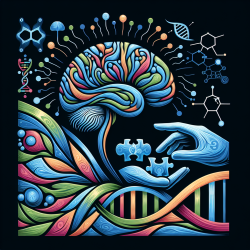Introduction
The study of autism has been a complex journey, with genetic factors playing a crucial role in understanding its etiology. The research article titled "A noise-reduction GWAS analysis implicates altered regulation of neurite outgrowth and guidance in autism" provides significant insights into the genetic underpinnings of autism. This blog aims to help practitioners enhance their skills by implementing the outcomes of this research or encouraging further exploration.
Understanding GWAS and Noise Reduction
Genome-wide association studies (GWAS) have been instrumental in identifying disease susceptibility genes. However, they often face challenges due to statistical noise and multiple-testing issues. The GWAS noise-reduction (GWAS-NR) method, as proposed in the study, offers a novel approach to increase the power to detect true associations, especially in complex diseases like autism.
Key Findings and Implications
The research utilized GWAS-NR to analyze autism datasets, resulting in the identification of significant linkage disequilibrium (LD) blocks and candidate genes. These genes are implicated in pathways that regulate the directional protrusion of axons and dendrites, crucial for synaptic connectivity. The study highlights the potential of GWAS-NR in prioritizing regions for follow-up studies, thereby enhancing the understanding of autism's genetic architecture.
Implementing Research Outcomes
For practitioners, incorporating the findings from this research can be transformative. Here are some actionable steps:
- Stay Informed: Regularly update your knowledge on genetic research in autism by attending conferences and webinars.
- Collaborate with Researchers: Engage with geneticists and researchers to understand the practical applications of GWAS-NR in clinical settings.
- Encourage Genetic Testing: Advocate for genetic testing in autism assessments to identify potential genetic markers and tailor interventions accordingly.
- Promote Further Research: Encourage research collaborations that focus on the pathways identified in the study, particularly those involving neurite outgrowth and guidance.
Encouraging Further Research
The study opens avenues for further research into the genetic mechanisms of autism. Practitioners can play a pivotal role by supporting research initiatives and fostering an environment conducive to scientific inquiry. By understanding the genetic basis of autism, interventions can be more targeted, potentially leading to improved outcomes for individuals on the spectrum.
Conclusion
The GWAS-NR method presents a promising approach to unraveling the genetic complexities of autism. By implementing the research outcomes and promoting further exploration, practitioners can contribute significantly to advancing autism research and therapy.
To read the original research paper, please follow this link: A noise-reduction GWAS analysis implicates altered regulation of neurite outgrowth and guidance in autism.










